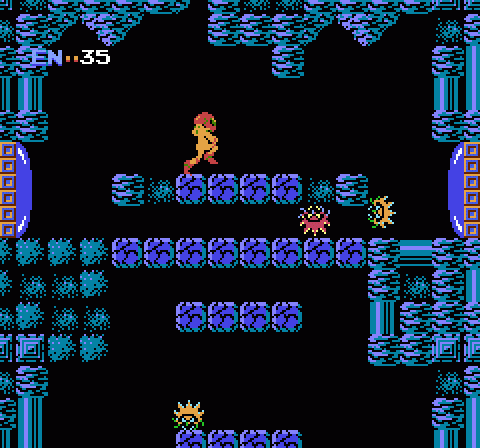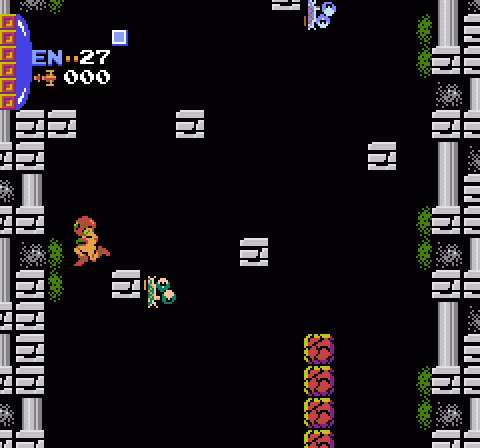The road to acquiring Metroid’s all-important Bomb has proved to be a surprisingly well-designed one, not quite guiding the player to Samus’ objectives but rather placing limitations on the game’s free-roaming spaces that allow some degree of exploration that eventually comes to an end until you stumble upon the next tool to help Samus range further afield. Remembering (or mapping) tantalizing points to return to further on in the adventure proves key to efficient play, imposing a small burden on the player — not a terrible one, simply enough to force them to become invested in the open-ended world.
In a time when even scrolling in a fixed direction had only been widely available on home consoles for about a year, Metroid expected a lot from players; yet it admirably didn’t simply chuck them in the deep end and demand they swim or drown. Brinstar and the road to the Bomb are perfect beginners’ pools. You can take issue with the game for its repetitive visuals or Samus’ weird jump physics or the way you restart the game with just 30 points of health every time (forcing you to dawdle around and farm health pick-ups whenever you continue) — but Anatomy of a Game is about the way well-designed games show you the ropes without resorting to in-ear navigation or tutorials. In that respect, Metroid does an admirable job.

Disappointingly, the game turns out to be somewhat less focused once you acquire the Bomb. That’s definitely a part of Metroid’s charm — you’re plopped into the middle of a vast extraterrestrial labyrinth and left to puzzle your way through the thing — but you can definitely see the rough edges here that serve as telltale signs of a young medium and an undefined genre. Beyond the Bomb, Metroid can be frustrating thanks to its combination of unavoidable visual monotony, obscure mechanics, and some very poorly conceived room layouts. Combined with the freedom to go pretty much anywhere and do just about anything, these can lead to some truly infuriating moments as you seek to conquer Norfair and the boss hideouts.
Part of the problem is that while the Bomb represents the last absolutely mandatory piece of Samus’ tool-arsenal, it’s not the last addition to her repertoire. Most of Metroid’s pick-ups take the form of Missile expansions or Energy Tanks, but you can find four other items within the labyrinth. One of them is almost completely useless; another is incredibly helpful though not mandatory; and finally, two of them may be technically non-mandatory, but you’ll find it difficult to finish the adventure without them.
However, these items are scattered throughout the game, and Metroid offers extremely little guidance to light your path to them. The most important of these, the Ice Beam, actually shows up in two different spots. However, one is deviously hidden, and the other is back in Norfair. The problem, though, is that players probably won’t go back to Norfair immediately after collecting the Bomb. Instead, they’ll almost certainly be enticed to venture into an area for which they’re ill-prepared but nevertheless can explore almost in its entirety… a process destined to end in failure.
While the next “proper” step in the game is to venture down into Norfair and find Ridley’s lair (and the useful doodad hidden thereabouts), the game really seems to want you to go to the “wrong” area instead. The path to Kraid’s hideout has been taunting you since the very beginning of the adventure: It’s the breakable rock floor in the room adjacent to Samus’ starting point. You’ve passed over it every time you’ve had to continue to head back to the tall, tall shaft, and with the Bomb in hand you can finally blow open the floor and see what lies below. Furthermore, the route from Norfair’s dead ends to the Bomb seems to be pointing in Kraid’s direction. You could certainly be forgiven for going there next.
With deft play, you can even reach Kraid. Now that you’ve learned the basics of the game, Metroid has very few new tricks up its sleeve, so the game beyond this point is more or less simply a matter of coming to terms with the vast sprawl of Zebes and not letting enemies get the best of you. Reaching him requires persistence and a small amount of curiosity… and also the sense not to be fooled by the fake Kraid that you can destroy in a single shot. Hey, the concept of bosses in video games was pretty new in 1986. You could be forgiven for not knowing how they work.

The problem is, should you head immediately to Kraid after getting the Bomb, you almost certainly can’t win. He hits pretty hard and soaks up far more damage than you can deliver with the paltry amount of Missiles you’ll have collected to this point. You can leave a boss’ lair at any time to regroup and recharge, but its health tally will reset and you’ll have to start from scratch. You’ll basically reach an impasse here… and should you elect to return to Brinstar, you’ll find the only route there consists of climbing a shaft of breakable blocks you can only ascend by shooting them away and waiting for them to reform. Should one of the blocks reform while you’re in its space, it’ll damage you and the recoil will send you flying back down to the bottom of the shaft. It’s a clever room design but not fun in the least. If you can’t get the timing down, the only way out is to die… which means respawning at the entrance to Kraid’s hideout with a piddling 30 points of health, per usual.
This isn’t a major design failure, and it’s not even something all gamers will experience. But it’s an example of the rough edges Metroid possesses, the small design oversights that can make it difficult for most people to go back after so many years of seeing these concepts refined by sequels and would-be successors.
Do you consider Kraid “wrong” purely from a difficulty perspective? Because he’s clearly presented as the first of two mini-bosses.
Yes. Ridley is hilariously easy to beat. Kraid’s lair is more meandering and he’s much harder to defeat.
You could make the case that the location and difficulty and hierarchy of the bosses being so scrambled is another goof…
the original Metroid…years later, i still haven’t recovered from my injuries from that one, considering that the game is harder than a Xenomorph’s shiny carapace. having experienced it for the first time as a unlockable bonus in Metroid Prime some time back in the mid-2ooo’s, I have yet to really sit down and graph-paper my way through the game, having maybe reached Kraid once (maybe…), only meet a quick demise. one of these days, perhaps…
btw, do you know if that version of Metroid (the Prime bonus) is a direct port, faithful to the original NES game down to the last detail?
in the meantime, i’m back on (what is probably) my 4th play-through of Super Metroid via emulator on my trusty Xperia during commutes. while the broken sound emulation aside, man, that game is still SO FRIGGIN’ GOOD~
now where was that metroid larva off to again?
One interesting trait of Metroid was to put the entrances to the hardest areas close to the start of the game. Ridley’s lair was harder to find but easier to beat. They even kept labeling Kraid as the first boss and Ridley as the second. Also, neither the instructions nor any of Nintendo’s magazines explained why Ridley was the easier one to beat. This may be the one thing about Metroid that wasn’t spoiled for me as a kid, and I still feel smug when I read about people suffering through Kraid first because you’re “supposed” to.
Yeah, difficulty aside, I’m pretty sure Kraid is “meant” to be the first boss. This was certainly always the way I did it. And both Super Metroid and Zero Mission give credence to this, since both more-or-less force him on you as the first boss (you could probably technically backtrack, but I believe all the tools you need to get to Ridley are in Brinstar, not Norfair). I would also say the enemies in Kraid’s Hideout (or “Brinstar Depths” as Smash Bros. likes to call it) are easier than those in Norfair.
You just have to make sure you farm up missiles and energy tanks before you fight him. And maybe the Varia Suit which is accessible with the ice beam and/or High Jump Boots (I forget if you need the ice beam if you have the boots… though I know you can get it without them, albeit maybe with some difficult bomb jumping).
Ultimately I’ll be honest - Norfair is always where I get super frustrated with this game and start to hate it. Even back in the day I don’t recall having *that* much trouble with Kraid’s Hideout. But the endless maze of identical rooms that is Norfair was (and still is without a map) too much.
The Offical Nintendo Player’s Guide identified Kraid’s lair as “Hideout I” and Ridley’s lair as “Hideout II”. The statue keys before Tourian are shown with Kraid’s physically placed first before Ridley. This lead me to believe that Kraid was the first boss to fight. However, Nintendo Power Volume 29 identifies Ridley as the first boss to fight due to how much easier he is. I have to wonder if Ridley simply had some AI issues in the original game as I remember I could simply stand right by Ridley’s platform and pump missiles into him while his fireballs would mostly sail harmlessly over me.
bdjeffyp, the difference between Kraid and Ridley is even more stark than that. You only need five missiles to fight Ridley because you can tear him apart with the Screw Attack. Just seven or eight jumps does it!
I’m surprised none of the FAQs out there mention this.
Correction: A few of the FAQs mention that it’s possible to screw attack Ridley.
I always just used bombs on Kraid. If you have the varia suit and 3 full energy tanks you can just spam him with bombs and he will die before you do unless you happen to fall into the lava on either side.
Samus using the screw attack on Ridley? Proof rule 34 existed even back in 1986 (I kiid I kiid).
Love the Q*bert references in the article’s title!
I think it’s almost certainly a design oversight. Kraid seems to be the first boss you’re supposed to beat… not only because it’s called Mini Boss Hideout 1, but also because the enemies in there do 16 damage whereas the enemies in Hideout 2 do 24 damage. Hideout 2’s enemies do the most damage of anything in the game before Tourian. And yet Ridley is so much easier to beat than Kraid… I always found this puzzling as a kid. Perhaps they just didn’t realize how easy Ridley actually was.
But then again, this is part of the game’s charm, too. There’s something kind of exciting about playing a game and finding out your assumptions were wrong, and genuinely being unsure about where you’re supposed to go next. Often I prefer that games would risk frustrating me rather than play it safe.